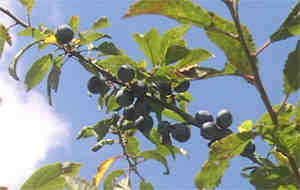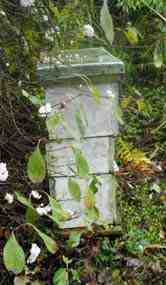The Great Sloe Gin Challenge – Three variations of our sloe gin recipe
Posted by Fiona Nevile in Liqueurs | 162 comments
Beautiful ripe sloes on the bush in September
“Pick after the first frosts,” advise the traditionalists.
“Pick them in September, before the bushes are stripped bare,” chortle the enthusiastic.
“Pick them now and give them a chilly blast in the freezer, to give the effect of the first frost,” suggest the practical.
There are other questions too. If the sloes are left to mature until the first frosts, do they have a better flavour? Does the quality of gin affect the liqueur? Should one strain gin from the sloes after three months, six months, ever?
I telephoned Gilbert to discuss this multiple conundrum. His advice was simple.
“Whatever you do, write it down on a label and stick it on the bottle. Then, if your brew is superb, you have the recipe. Note the tree, the time of picking, the gin and the amount of sugar and sloes. If you used almond essence, note how much on each label.”
I recalled that the most interesting part of his cellar was the vast liqueur wall. The label on each bottle and demijohn was covered in microscopic notes.
“Remember that the combination of gin, sloes and sugar is always better that the separate ingredients, no matter what you do.”
He is right. sloe gin sipped on a cold winter’s night is deliciously dangerous.
We have decided to run The Cottage Smallholder sloe gin test. We are going to make sloe gin now under laboratory conditions in the Cottage Smallholder kitchen. The sloe gin will by tasted and evaluated by a team of three experienced sloe gin drinkers.
Using the same gin (supermarket medium quality) and the same recipe, we are going to make sloe gin with three batches of sloes harvested from the same tree.
- The first bottle will contain freshly picked sloes, picked now in mid September.
- The second will have fresh sloes picked now but which will have had a night in the freezer.
- After the first frosts we are going to return to the same tree with a ladder to collect the frosted sloes that an average height forager can’t reach. The third bottle will contain these.
We will publish are results in a few months time.
Two years later we published the results of the sloe gin recipe challenge.
Sloe Gin Recipe:
Ingredients:
- 1lb/454gm of washed sloes
- 4 ozs/112gm of white granulated sugar
- 1 75cl bottle of medium quality gin
- Sterilised 1 litre (at least) Le Parfait jar or wide necked bottle
- 1 small quarter tsp almond essence
Method:
- Wash sloes well and discard any bruised or rotten fruit. Prick fruit several times with a fork and place sloes in either a large Kilner/Le Parfait jar or a wide necked 1 litre bottle. I put several sloes in my palm to prick them rather than picking them up one by one.
- Using a funnel, add the sugar and top up with gin to the rim. Always open sugar bags over the sink as sugar tends to get caught in the folds at the top of the bag.
- Add the almond essence.
- Shake every day until the sugar is dissolved and then store in a cool, dark place until you can resist it no longer (leave for at least three months, we usually let it mature for a year).
- Some people strain the grog (through muslin/jelly bag) after 3 months and bottle it, leaving it mature for six months. We usually strain and bottle after a year. We use some beautiful old heine brandy bottles with cork lids. If you are feeling flush Lakeland sell some pretty bottles here. Don’t leave the straining process any longer than a year; leaving the fruit in too long can spoil the liqueur.
For loads more tricks and tips on making sloe gin see the original sloe gin recipe
Leave a reply






.nice with lemonade
Hi
I made my usual sloe gin last year in October and tasted it just before Christmas but it was far too strong. Anyone have any ideas as to how I can improve the taste? – I have only just remembered it is stll in the bottom of my airing cupboard!
Thanks
Jennyw
Hi, Please can anyone tell me how long it normally takes for sloe gin to turn syrupy? I used recipe 1lb sloes, 4oz sugar and 1 litre of gin. It is a beautiful ruby red colour, but is not turning to syrup. It has been brewing for 5 weeks. Should I add more sugar? Any help would be greatly appreciated. Mary-Jane
The Sloe Sherry had to be tried, probably too soon, but well worth the effort. I drank half a bottle of sweet sherry, added recycled sloes to top up the bottle and agitated daily for three weeks and tasted – rather nice.
Thank you Geraldine for the suggestion of adding the recycled sloes to vanilla ice cream. It shall be tried soon.
One of our standby sweets for hasty super parties is to layer Black Cherry pie filling and Greek style Yoghurt. It both looks and tastes good. The problem is that we used to use ‘Morton’s’ pie filling and this seems no longer to be available unless you know different in which case a pointer would be very much apreciated.
Our substitute is bottled cherries from Lidl. They are not really as good and you have to watch out for the odd one which still has a stone in it.
Perhaps I should try sloes and add some sugar to combat the sourness. The pitting / de-stoning process is a bit daunting though.
Sloes in our part of the country are scarce this year. I suppose there is a moral to this which could be based on making hay but one won’t come to mind as I write.
Many thanks,
Regards,
Dai.
Fantastic site, just love it.
I have lots of bunches of grapes which are only the size of sloes, they’re just turning from green to purple.
Trouble is every year they are wasted because they are so sour. Does anyone know if they could be used in gin or vodka?
Mo, Sheffield
Hi Geraldine
There are teeny ammounts of cyanide in the pips of a lot of fruit but it is perfectly safe to drink sloe gin/vodka that has had the sloes soaking for ages.
Lot’s of people worry about this (see Gill’s comment above) but there’s no danger.
I was discussing damson gin with someone and mentioned that I leave the fruit in the bottle (as with sloe gin) and they have scared the pants off me by saying all the cyanide will leak out of the stones and kill me!
Is this true? Does anyone have any evidence of this (if I don’t hear anything then it must be true).
By the way Dai, we always have our used sloes with a good quality vanilla ice cream.
Just wondering what was the outcome of the experiment?
I have enjoyed reading all the comments many of which have struck chords.
If you allow the light to get at your sloe gin, that wonderful deep colour will be diminished.
When I bottle, I use old malt whisky bottles which come in tubes. The tube protects the contents from the light. If you use a supermarket gin, try to find one with a green glass bottle, this will help to reduce the effect of the light. Using a brown demijohn also helps. Nothing beats no light at all.
I have found that if you leave the sloes in the freezer for too long before you use them (months), the colour of the liquor will be much paler than I prefer.
When I bottle my ˜Very Sloe Gin™ I add a Best After Date at the bottom of the label. This is never less than 5 years after bottling. It was the best way I could think of to keep people off it.
When we moved last year, I found some forgotten remnants still on fruit in a demijohn after several years. Some kind person had put it in the greenhouse so it had plenty of light. It had paled to a rich golden colour. It was very strong but still OK.
I hope to try making Queimada next year when we return to Los Nietos, Mar Menor. ˜Carthago™ is a local brand of aguadiente from a distillery in Cartagena. I have used sloe gin proportions to make an orange liqueur using brown sugar and orange peel.
I am waiting for my lemon gin to mature before.
I am considering using dried apricots in aguadiente too. This overcomes the problems I have with using damsons “ too much moisture in the fruit.
I use recipes from ˜The Homelover™s Encyclopedia™ from around 1900. It is full of some great ideas from long before the days of heavy excise duty.
I am still looking for a really good use for the used sloes. I have 5 kgs in the freezer.
Hi Ben
I don’t have a recipe for raspberry whisky but it would be similar to blackberry whisky – the recipe is here http://www.cottagesmallholder.com/?p=422 Just leave the raspberries in the whisky for 6 months instead of 3.